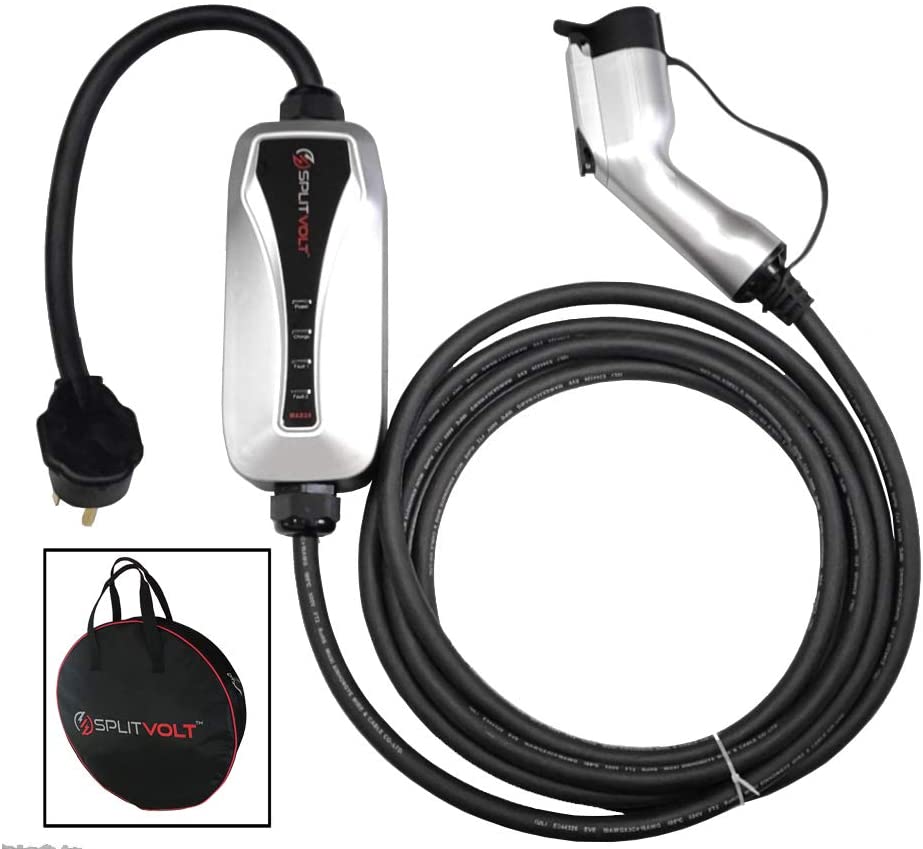PROS: Fast charging speeds, IP55 rated, very light.
CONS: Short cable.
| Product | Amp rating | Level | Cable Length | Nema | Power | Price |
|---|---|---|---|---|---|---|
The 24 Amp Charger – SplitVolt  | 24 Amp | Level 2 | 16.4 Feet (4.9 M) | NEMA 10-30 & NEMA 14-30 | 6.6 kW | Click for more info |
The 24 Amp Charger – SplitVolt Specifications
| Amp rating | 24 Amp |
|---|---|
| Level | Level 2 |
| Type | Portable EV Charger |
| Cable Length | 16.4 Feet (4.9 M) |
| Nema | NEMA 10-30 & NEMA 14-30 |
| Power | 6.6 kW |
| Voltage | 240V |
| Connector | J1772 |
| Connectivity | None |
| IP Rating | IP55 |
| Display | 4 LED Lights |
| Warranty | 1-Year No-Hassle |
| Features | Portable Fast Home Charging, No Installation Required, Real-time Charging Status , Safe Universal Charging, Empowering Electric Vehicle Adoption, Charge with Peace of Mind, High Charging Capability |
| What’s in the box | Charger, Plug, Cable, Connector |
| Weight | 7.7 lbs (3.5 kg) |
| Features | Tethered, Alexa & Google Home, Charge Scheduling |
The 24 Amp Charger – SplitVolt Charging specifications
This 24 Amp EV Charger which is made by SplitVolt can output 6.6 kW of power to your electric car. It is a Level 2 charger, so you need to connect it to a 240V outlet. In order to take advantage of its full power, it is best to connect it to a 30 Amp circuit. But let’s have a look at how these 24 Amps translate into charging times.
For example, the standard Tesla Model 3 will charge in just 7-8 hours, the Model Y would take between 10-12 hours, a 40 kWh Nissan Leaf should charge in 6-7 hours and a Kia Niro or a Hyundai Kona would take about 10-11 hours to fully charge.
So you can see that this 24 Amp charger adds quite a lot of miles of range per hour of charge at this charging rate. And speaking of that, the manufacturer also states that the device’s charging rate is “approved by the National Electric Code (NEC)”. So I guess if it is good enough for the folks at NEC it is good enough for me.
The 24 Amp Charger – SplitVolt Cable types and connectors
Now this 24 Amp Charger can be plugged into either a NEMA 10-30 or a NEMA 14-30 outlet. If you need to install a new outlet or update the one that you have in your garage, the same manufacturer that makes the SplitVolt chargers (SplitVolt Inc), also makes the SplitVolt Splitter switches. This is the one that should be perfectly compatible with this 24 Amp Charger. It splits a 10-30 into two outlets, a Dryer Outlet and an EV charging station outlet.
Now as far as the other end of the EV charge cable is concerned, it uses an SAE J1772 connector which is universal to most EVs sold in north America, so it will be compatible with any Ford, Toyota, Kia, Hyundai, Nissan EV or Plug-in Hybrid. Tesla models are the only ones which don’t use this port, but even they come with an adapter.
The only slight problem is that the cable might not always be long enough because it only measures 16.4 feet (4.9 meters). Luckily it is a portable EV charger, so you do get some flexibility there. The cables on chargers in America are all permanently connected, so you can’t simply disconnect them like you would in Europe. However, if you need a longer cable, you can always get an extension cord.
The 24 Amp Charger – SplitVolt Features
There’s no connectivity on this 24 Amp portable charger, but then again I have not found one portable charger that offers WiFi or Bluetooth, so it’s not anywhere below other chargers. There is no Amazon Alexa integration or charge scheduling, although the latter function can be found usually in your EV’s dashboard. The idea is to schedule the charging process so that it uses as much off-peak electricity as possible which in the long run will save you some money and who doesn’t want to do that.
It comes with an IP55 rated enclosure so it is waterproof and dustproof. On the control box you’ll find a total of 4 indicating lights which tell you whether the charger is powered on, whether it is delivering energy to the vehicle or whether there is a fault (2 lights dedicated to faults).
The manufacturer offers a 1-Year No-Hassle warranty on this 24 Amp charger. They say it offers “internal vehicle power protection” which would probably equate to overvoltage and overcurrent protection.
